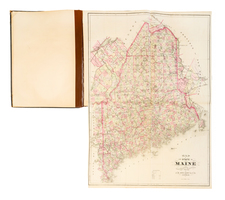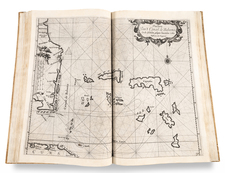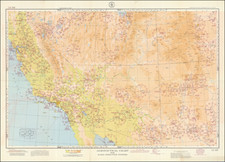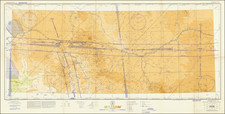"Get Your Kicks on Route 66"
Holbrook, Arizona in 1927
A fire insurance atlas of Holbrook, Navajo County, Arizona, produced by the Sanborn Map Company in November 1927 (copyrighted 1928), offers a detailed record of the built environment of this Arizona town on Route 66, during an era of rapid expansion in the American Southwest fueled by automobile travel. Comprising three unbound sheets with hand-colored maps, the atlas was originally made as a specialized tool for insurance company underwriters in determining the degree of fire risk associated with any property shown therein. Today it is an unrivaled visual record of Holbrook's urban and architectural landscape for the time.
Executed with a scale 600 feet to an inch, every building in Holbrook is accurately shown with block-by-block, street-by-street, structure-by-structure representations. Use of each structure is given: dwelling, grocery, storage, lumber yard, church, hardware, water tower, etc., often recording the name of the individual business owner. Color coding denotes building material. Notably, many of the buildings in Holbrook, including the City Hall, are noted as made of adobe.
During the 1920s, Holbrook, Arizona, a town of 1200 people, functioned as a key transportation and commercial hub in Navajo County, serving as a critical junction for both the Santa Fe Railroad and historic Route 66. Situated near the Petrified Forest National Park, the town benefitted from a burgeoning tourism industry while also maintaining its foundational agricultural and livestock-raising activities. As a microcosm of the era's transformative energies, Holbrook experienced the encroaching influence of modernization, seen through an increase in automobile traffic, the establishment of new businesses, and some infrastructural improvements. For a town of about 1000 people, Holbrook supported an impressive range of small businesses that catered to the burgeoning community: automobile dealers and service shops, banks, a dance hall, a movie theater, a printing establishment, hardware stores, butcher shops, and the like.
Here follows a selection of the structures and sites shown in the atlas:
- City Hall (Adobe)
- Babbit Bros. Wholesale Grocery Warehouse
- Cooley Lumber Co.
- L. B. Putney Wholesale Grocery Warehouse
- Holbrook Ice & Light Plant
- Hotel Holbrook
- Holbrook High School
- Navajo County Court House
The document bears witness to a confluence of architectural styles in this Southwestern town, as well as modern infrastructural developments favoring automobile travel. The inclusion of various civic institutions, commercial buildings, and residential structures fully illustrates Holbrook's urban environment.
For nearly a century (from 1867 to 1961), Sanborn Map Company produced their fire insurance maps for nearly all U.S. cities. Ron Tyler (Prints of the West, pages 153-55) describes the fire insurance maps as a successor to the bird’s-eye view in documenting the growth of towns and cities. The present Holbrook atlas bears out Tyler's assertion.
Rarity
The Holbrook Sanborn atlas is rare. Not a single example is located in OCLC. California State Northridge lists a 1943 edition of the Holbrook Sanborn atlas, but not the present 1927 edition. The Library of Congress has digitized their example of the 1927 edition.
The Sanborn Map Company, founded in the 1860s by Daniel Alfred Sanborn, is a renowned cartographic institution primarily recognized for its unparalleled fire insurance atlases. These atlases emerged as indispensable tools during the late 19th and early 20th centuries, portraying the evolution of urban America with unprecedented detail and precision. Charting both burgeoning metropolises and smaller municipalities, Sanborn's fire insurance maps provide a unique and illuminating perspective on the physical, economic, and social transformation of the nation during a period of intense urbanization and industrialization.
During the latter half of the 19th century, the United States witnessed an acceleration in urban growth. This shift from rural to urban living, bolstered by the advent of the Industrial Revolution, generated densely populated areas with a diverse array of architectural styles, materials, and infrastructure. In this context, the need for comprehensive maps that could illustrate the specifics of the built urban fabric became paramount, especially for insurance companies seeking to assess the risks associated with insuring individual properties. The Sanborn Map Company responded to this demand, creating elaborate maps that identified building materials, the purpose of structures, and even features like fire walls and sprinkler systems.
A standout feature of Sanborn's maps was their color-coding system, which allowed for a swift and clear differentiation between building materials—whether wood, brick, iron, or otherwise. This system, paired with the company's legends -- detailing everything from the width of streets to the locations of hydrants -- made these atlases an invaluable resource for insurance underwriters. By the turn of the 20th century, Sanborn maps covered thousands of cities and towns across the United States.
Beyond their utility to the insurance industry, the atlases produced by the Sanborn Map Company have, over time, become a treasured resource for historians, urban planners, preservationists, and environmental researchers. These maps have also been pivotal in brownfield research, shedding light on past industrial activities and potential contamination sites. They offer a window into the past, capturing the architectural, infrastructural, and environmental trends of various eras, and revealing the intricacies of a city's development. The very design of streets, the evolution of residential and commercial areas, and the rise and decline of certain industries can be traced through these maps.
Around 1960, Warren Buffett, then a burgeoning value investor, took a significant position in Sanborn Map Co., sinking 35% of his partnership's money into the company. Buffett was drawn to Sanborn's extensive map business, which he described as a virtual monopoly, as well as the company's valuable investment portfolio. While the cartographic aspect of Sanborn's business was diminishing in profitability due to technological advances introduced by competitors, Buffett recognized that the informational content of the maps had not been updated to electronic access, and was thus an undervalued asset for the company. His investment in Sanborn Map Co. is often presented as Case Study No. 1 in overviews of his value-oriented investment philosophy, which emphasized undervalued assets.
In sum, the Sanborn Map Company's fire insurance atlases are not merely maps; they are intricate tapestries of American urban history, detailing the nation's progression from the late 19th to the 20th century. Through their detailed renderings, these maps continue to serve as invaluable chronicles of the United States' urban transformation during a pivotal era.












![[ Atlas of The United States ] Karte von Amerika](https://storage.googleapis.com/raremaps/img/small/84353mp2.jpg)

![[ Ethnographic Thematic Atlas - Poland, Lithuania, Ukraine, etc. ] Völker-Verteilung in West-Russland (Distribution of Peoples in Western-Russia)](https://storage.googleapis.com/raremaps/img/small/94045.jpg)

